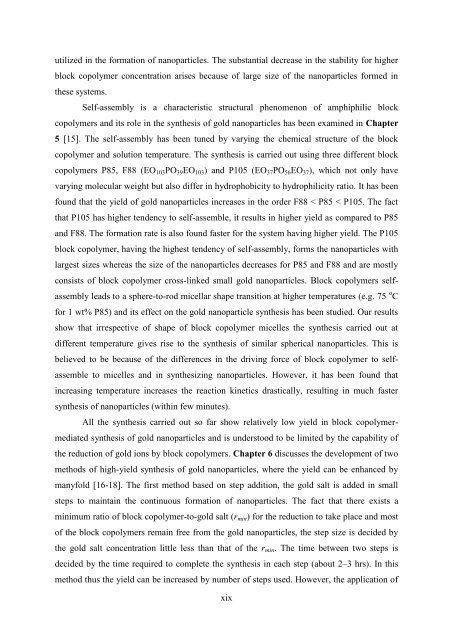PHYS01200704032 Debes Ray - Homi Bhabha National Institute
PHYS01200704032 Debes Ray - Homi Bhabha National Institute
PHYS01200704032 Debes Ray - Homi Bhabha National Institute
You also want an ePaper? Increase the reach of your titles
YUMPU automatically turns print PDFs into web optimized ePapers that Google loves.
utilized in the formation of nanoparticles. The substantial decrease in the stability for higher<br />
block copolymer concentration arises because of large size of the nanoparticles formed in<br />
these systems.<br />
Self-assembly is a characteristic structural phenomenon of amphiphilic block<br />
copolymers and its role in the synthesis of gold nanoparticles has been examined in Chapter<br />
5 [15]. The self-assembly has been tuned by varying the chemical structure of the block<br />
copolymer and solution temperature. The synthesis is carried out using three different block<br />
copolymers P85, F88 (EO 103 PO 39 EO 103 ) and P105 (EO 37 PO 56 EO 37 ), which not only have<br />
varying molecular weight but also differ in hydrophobicity to hydrophilicity ratio. It has been<br />
found that the yield of gold nanoparticles increases in the order F88 < P85 < P105. The fact<br />
that P105 has higher tendency to self-assemble, it results in higher yield as compared to P85<br />
and F88. The formation rate is also found faster for the system having higher yield. The P105<br />
block copolymer, having the highest tendency of self-assembly, forms the nanoparticles with<br />
largest sizes whereas the size of the nanoparticles decreases for P85 and F88 and are mostly<br />
consists of block copolymer cross-linked small gold nanoparticles. Block copolymers selfassembly<br />
leads to a sphere-to-rod micellar shape transition at higher temperatures (e.g. 75 o C<br />
for 1 wt% P85) and its effect on the gold nanoparticle synthesis has been studied. Our results<br />
show that irrespective of shape of block copolymer micelles the synthesis carried out at<br />
different temperature gives rise to the synthesis of similar spherical nanoparticles. This is<br />
believed to be because of the differences in the driving force of block copolymer to selfassemble<br />
to micelles and in synthesizing nanoparticles. However, it has been found that<br />
increasing temperature increases the reaction kinetics drastically, resulting in much faster<br />
synthesis of nanoparticles (within few minutes).<br />
All the synthesis carried out so far show relatively low yield in block copolymermediated<br />
synthesis of gold nanoparticles and is understood to be limited by the capability of<br />
the reduction of gold ions by block copolymers. Chapter 6 discusses the development of two<br />
methods of high-yield synthesis of gold nanoparticles, where the yield can be enhanced by<br />
manyfold [16-18]. The first method based on step addition, the gold salt is added in small<br />
steps to maintain the continuous formation of nanoparticles. The fact that there exists a<br />
minimum ratio of block copolymer-to-gold salt (r min ) for the reduction to take place and most<br />
of the block copolymers remain free from the gold nanoparticles, the step size is decided by<br />
the gold salt concentration little less than that of the r min . The time between two steps is<br />
decided by the time required to complete the synthesis in each step (about 2–3 hrs). In this<br />
method thus the yield can be increased by number of steps used. However, the application of<br />
xix

















